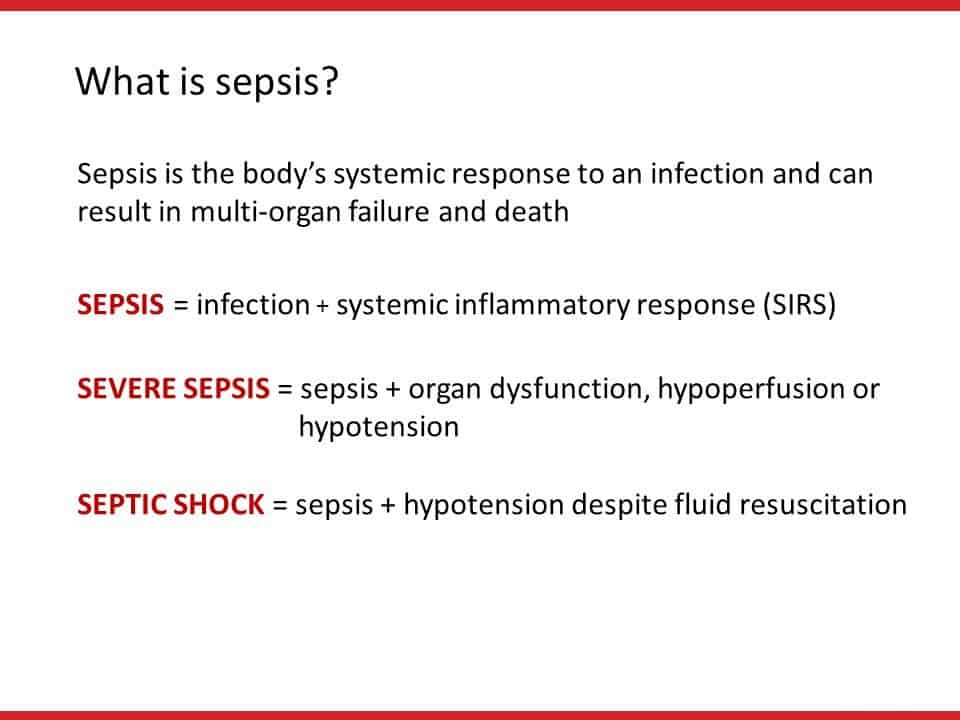What is Sepsis?
Sepsis is the body’s overwhelming and life-threatening response to infection that can lead to tissue damage, organ failure, and death. In other words, it’s your body’s overactive and toxic response to an infection. Sepsis is a multi-system organ dysfunction caused by infection.
Your immune system usually works to fight any germs (bacteria, viruses, fungi, or parasites) to prevent infection. If an infection does occur, your immune system will try to fight it, although you may need help with medication such as antibiotics, antivirals, antifungals, and antiparasitics. However, for reasons researchers don’t understand, sometimes the immune system stops fighting the “invaders,” and begins to turn on itself. This is the start of sepsis.
Some people are at higher risk of developing sepsis because they are at higher risk of contracting an infection. These include the very young, the very old, those with chronic illnesses, and those with a weakened or impaired immune system.
Patients are diagnosed with sepsis when they develop a set of signs and symptoms related to sepsis. Sepsis is not diagnosed based on an infection itself. If you have more than one of the symptoms of sepsis, especially if there are signs of an infection or you fall into one of the higher risk groups, your doctor will likely suspect sepsis.
Sepsis progresses to severe sepsis when in addition to signs of sepsis, there are signs of organ dysfunction, such as difficulty breathing (problems with the lungs), low or no urine output (kidneys), abnormal liver tests (liver), and changes in mental status (brain). Nearly all patients with severe sepsis require treatment in an intensive care unit (ICU).
Septic shock is the most severe level and is diagnosed when your blood pressure drops to dangerous levels.
Source: www.sepsisalliance.org
Top 11 Things Everyone Should Know About sepsis:
- Sepsis is a life-threatening condition that arises when the body’s response to infection injures its own tissues and organs.
- Sepsis is a medical emergency. Minutes matter.
- No one is immune. Sepsis can strike anyone regardless of age, race, color, or creed.
- Despite more than 1.6 million cases a year, just over half of Americans have heard of sepsis.
- Sepsis kills more people in the US than breast, lung and prostate cancer combined.
- Sepsis kills more kids in the US than cancer.
- There is no single sign or symptom of sepsis.
- Warning signs can include dizziness, shortness of breath, confusion, and sleepiness.
- Delays in antibiotic administration can increase the risk of death from sepsis.
- There is no FDA-approved therapy for sepsis. Immediate treatment with antibiotics and fluids could cut the number of deaths in half.
- If you are worried about sepsis, tell your healthcare provider: “I am concerned about sepsis.”
Source: www.sepsisalliance.org
Critical Facts:
- Sepsis is the leading cause of death in U.S. hospitals.
- 62% of people hospitalized with sepsis are re-hospitalized within 30 days.
- As many as 92% of sepsis cases originate in the community.
- Mortality from sepsis increases 8% for every hour that treatment is delayed. As many as 80% of sepsis deaths could be prevented with rapid diagnosis and treatment.
Human Cost
- Sepsis affects over 26 million people worldwide each year and is the largest killer of children – more than 5 million each year.
- More than 1.6 million people in the U.S. are diagnosed with sepsis each year – one every 20 seconds and the incidence is rising 8% every year.
- 258,000 people die from sepsis every year in the U.S. – one every 2 minutes; more than from prostate cancer, breast cancer and AIDS combined.
- More than 42,000 children develop severe sepsis each year and 4,400 of these children die, more than from pediatric cancers.
- Sepsis causes at least 75,000 maternal deaths every year worldwide and is driving increases in pregnancy-related deaths in the U.S.
- Every day, there is an average of 38 amputations in the U.S. as the result of sepsis.
- Sepsis survivors have a shortened life expectancy, are more likely to suffer from an impaired quality of life, and are 42% more likely to commit suicide.
Economic Cost
- Sepsis is the #1 cost of hospitalization in the U.S. consuming more than $24 billion each year.
- The average cost per hospital stay for sepsis is $18,400, double the average cost per stay across all other conditions.
- Sepsis is the #1 cause for readmission to the hospital costing more than $2 billion each year.
Awareness
- Just 55% of U.S. adults have heard of sepsis.

